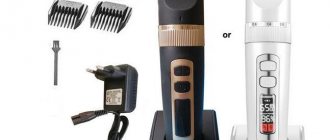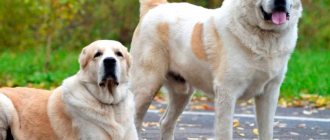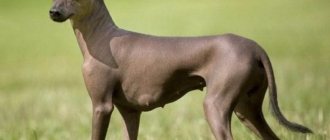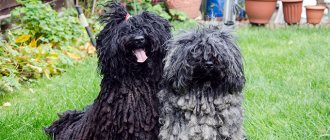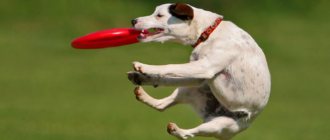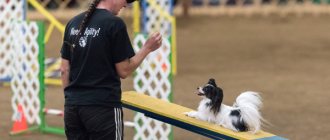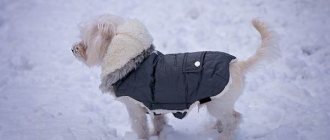Many owners don't want to limit themselves to just dog training. The tailed pet must move more, becoming strong, fast, resilient, and dexterous. By playing sports, the pet learns to make independent decisions; the sense of smell, hearing, and vision acquire the greatest sensitivity. By getting into good shape through sports, the dog becomes healthier and more energetic. If the owner decides to make his pet an athlete, then it is necessary to take training and obedience courses, consult with a veterinarian to identify contraindications and choose a sport in accordance with the physical form and breed of the pet. There are many types of competitions. With their help, you can develop the necessary qualities of the animal.
Agility
This is a new dynamic sport. The dog and the owner take part in it. The goal is to complete the course with obstacles with a minimum number of mistakes. The dog must complete the cross-country course without motivators (sweets and toys), obeying only commands. The dog should not have a collar or leash. The four-legged athlete must be over a year old. Competitions are held for three categories of dogs, depending on their size.
Many amateurs hold local competitions, in which even cats can participate. They themselves organize obstacles for their pets and invite guests to this show. Items such as a podium can be purchased using the TRIBUNY.RF information portal. And you can make sports structures yourself; many owners of four-legged animals have golden hands. These competitions may not be professional, but they will unite pet owners and help keep their pets in shape.
Popular Sports for Dogs
Each of the existing dog sports has its own history and rules. The most popular of them will be discussed below.
Agility
Agility is the most popular sport, which involves completing a course with obstacles in a minimum amount of time. It is divided into 3 types of difficulty:
- Level 1 – for beginners;
- Level 2 – for animals that have received an “excellent” rating at least 3 times for the first level;
- Level 3 – for four-legged professionals who have taken one of the prize places at least 3 times in competitions of the second level of difficulty.
Anyone is allowed to level 1, including outbred pets without breeding documents. Despite the absence of restrictions, it is important to understand that an overweight and sedentary animal is unlikely to take a prize. Because of this, agility is not suitable for older dogs and overweight pets. Participation is also contraindicated for puppies under 1 year of age, pregnant dogs and dogs weakened by illness.
Before the start of the competition, all participants are divided into 3 groups based on their height at the withers:
- up to 35 cm – Welsh Corgi, Spitz, Chihuahua;
- 35-45 cm – Shiba Inu, Jagdterriers, beagles;
- more than 43 cm – mastiffs, deerhounds, great Danes.
The group assigned to an animal determines not only its potential rivals, but also the height of the obstacle. The competition is opened by the smallest participants.
To win, the animals must go through an obstacle course of various barriers:
- swing;
- boom (trapezoidal bridge);
- tunnel;
- slide;
- regular, double and barrier fence;
- ring;
- benches;
- slalom;
- podium.
The number of equipment placed in the ring depends on the experience of the participants. Beginners are allowed no more than 15 pieces, and four-legged veterans - no more than 20. Animals that have received level 3 are allowed to participate in national and international competitions.
Canine freestyle, or dancing with a dog
A relatively new type of competition for dogs, combining elements of dance and various tricks. The dance program is compiled by the owners themselves, and the judges evaluate the consistency of its execution and the obedience of the pets. Freestyle championships are held under the leadership of the FCI.
Frisbee dog
This gambling discipline appeared thanks to the illegal actions of Alex Stein, an ordinary Californian who decided to draw attention to his whippet named Ashley. His dog not only easily reached speeds of up to 56 km/h, but also caught a Frisbee extremely masterfully, jumping up to a distance of 2.7 m behind it.
Alex Stein tried for a long time to get into the talent show with his favorite, but his applications were stubbornly ignored. Then the man decided to use a trick. He went to a nationally televised baseball game in real time and smuggled a Frisbee with him. During a break in the game, Ashley, along with her owner, found herself on the field and for a full 8 minutes quite successfully entertained the audience with a demonstration of catching a flying disc. Despite the positive response from the crowd, the man was still arrested.
Alex Stein was saved from prison by businessman Irv Bander, who was one of the spectators that day. Together with his unlucky owner, he was able to develop dog frisbee into an independent sport and popularized it throughout the world.
Depending on the rules, dog frisbee is divided into 2 types: mini-distance and freestyle frisbee. In the first case, the animal is required to catch the plate at the maximum distance from the thrower, and in the second, it is required to perform various tricks prepared by the owner to the music.
Sledding sport, or sled dog racing
This sport with a dog involves covering a distance against time using the draft power of one or more four-legged dogs. Its place of origin is Alaska.
INTERESTING!
Sled dog racing was included in the 1932 Winter Olympics.
Due to its extraordinary popularity among dog lovers around the world, sledding sport was eventually divided into 2 groups:
- Winter racing
. Includes traditional sled racing over 3 distances of different lengths, skipuling and skijoring. The last two disciplines are competitions between skiers. In the first case, the animals pull behind them a skier and a small sleigh, and in the second - only a skier moving in a free style.
- Snowless racing
. They include dog-karting (racing with special carts - karts), bike joring (racing cyclists), canicross (racing runners) and dog-scootering (racing scooters).
Depending on the discipline, there are from 1 to 8 animals per person. The largest number is used for transporting sleds, but in the same dog-kart, only one pet is enough.
Waitpulling
Weightpulling arose in the same years as sledding, that is, during the Alaskan gold rush. Both species developed in parallel, so many tetrapods alternately took part in both. Weightpulling acquired its official status a little later than sled racing - in 1978.
The essence of this discipline is to move a load lying on a cart or sled over a certain distance in the shortest possible time. To avoid injury, all four-legged participants must wear a harness.
The best results in weightpulling are shown by large fighting (pit bulls, Amstaffs, Dogo Argentinos) and sledding breeds (Alaskan malamutes, Siberian huskies). The competition consists of 5-12 rounds, during which the weight of the load is constantly increased. The starting weight depends on the body weight of the animal:
- 100 kg – less than 10 kg;
- 200 kg – 10-20 kg;
- 250 kg – 20-30 kg;
- 300 kg – 30-40 kg;
- 350 kg – 40-50 kg;
- 400 kg – more than 50 kg.
According to the rules, the platform with the load must be moved approximately 5 m within 1 minute. Verbal encouragement is allowed on the part of the owners in order to motivate the pet.
Dog-pulling
A young dog sport that originated in Russia. Its founders are members of an amateur pit bull club, so it was their pets who became the first participants.
The essence of the discipline is to pull a three-meter rope between two animals after receiving a command from the owners. The grade is given based on the points collected. They are awarded for every 10 seconds of pulling to your side (1 point) and for direct victory (10 points). Thanks to these rules, even the one who ultimately missed the rope can win.
Coursing or greyhound racing
Coursing is the oldest type of cynological sport, which replaced classical hunting. It is a speed competition where instead of a real hare a mechanical one is used - a special device consisting of a reel, an electric motor and bait in the form of:
- plastic bag;
- washcloths;
- half-meter skin;
- plastic bottles.
The rope, wound as the animals run, sets the bait in motion, awakening the hunting instinct in the participants. First of all, speed is assessed during running, so the best results are usually shown by greyhounds, hounds and some Spitz-type dogs.
Although speed is important, being first is not enough to win. When assigning the final score, judges also take into account the following factors:
- maneuverability;
- enthusiasm;
- intelligence;
- endurance.
The underdog dog can outperform the fastest runner thanks to better cornering, hunting excitement, successful shortcuts, and excellent health throughout the race and immediately after its completion. Animals older than 15-18 months are allowed to compete.
Pitch and go
A Japanese team sport that is not an official standard. For this reason, any pets are allowed, regardless of their age, breed or pedigree.
The rules of pitch and go are similar to dog frisbee. Within 1.5 minutes, the dog must retrieve to its owner as many objects as possible (except frisbees) thrown on the ground. Throws must take place strictly within the ring, divided into zones that give different amounts of points. In addition to the objects brought by the dog, the sum of the final points is determined by the number of throws made by the owner and the zones into which the objects fell.
Flyball
These competitions appeared completely by accident - thanks to banal human laziness. In the 1960s, one Californian got so tired of constantly throwing a ball to his pet that he decided to find a mechanical replacement. He took the machine for throwing tennis balls as a basis and turned it into a special flyball machine that served balls to the dog after pressing a button.
A little later, the invention attracted the attention of Barbara Weatherwalks, the daughter of the trainer who worked with the collie from the movie “Lassie.” It was she who became the founder of the discipline.
The essence of flyball is to go through an obstacle course with several teams of 4 dogs, start the installation by pressing a button, then grab the ball and go through the obstacles again on the way back. The winner of the competition is the team that manages to bring the owner the most trophies in the shortest time.
Springpole
The competition originates from the USA and is popular among owners of pit bulls, amstaffs and staff bulls. All these animals are united by a powerful jaw and a developed prey drive.
The essence of springpole is to hang for a long time on a rope attached at a height of 1.5 m. 3 attempts are given to grab. The clinging dog should hang on it for as long as possible, but no more than 5 minutes. The winner is chosen based on the number of attempts used, strength and time of capture. Extra points are awarded to those who swing like a pendulum during the hold.
NOTE!
Animals older than 1 year and whose bite has already formed are allowed to participate in the competition.
Coursing
Hunting for imitation prey. As a rule, this is a mechanical hare. The hardy and smart animal wins.
This is not all sports. You can play football, hockey, diving, etc. with your pet. Each owner can choose the one where his pet’s abilities will be maximally realized. It doesn't matter which one you choose. By working with your dog, you will learn to understand it, and you yourself will be able to maintain excellent shape. It doesn't matter what result you achieve. Unforgettable emotions and pleasure are guaranteed to you. The dog will love you even more, become even more devoted and obedient.
4.7 / 5 ( 55 votes)
Dog Breeds Ideal for Sports
Sports dog breeds that are ideal for sports include those who show the greatest activity and liveliness of character. Most of them are hunting and service:
- English pointers;
- setters (Irish, Scottish, English);
- retrievers (Labrador retriever, golden, chesapeake bay);
- spaniels (cocker spaniel, English springer spaniel);
- Shepherd dogs (border collie, German, Mudi, Sheltie, Welsh Corgi);
- greyhounds (Salukis, greyhounds, Italian greyhounds, whippets);
- hounds (ridgebacks, dalmatians);
- Spitz-types (Xoloitzcuintle, Basenji, Peruvian and Mexican hairless dogs);
- Dobermans.
The canine elite includes all of the listed shepherd dogs. Thanks to their high intelligence and innate attachment to humans, they are easier to train and predict the owner’s wishes even before giving a sign.
Special mention should be made of terriers, Rottweilers, St. Bernards and collies. They are also good in dog competitions, but have a number of disadvantages: the first ones quickly lose concentration, the second ones take too long to move along the track due to scrupulous adherence to the rules, the third ones are not designed for jumping, and the last ones love to voice when they shouldn’t.
Dog fitness – beauty and health of your dog
For pets actively participating in exhibitions, there are special trainings and dog fitness. You can do fitness starting from 5-6 months of age, combining light loads with handling. Such exercises allow you to strengthen all joints and ligaments, correct the dog’s movements, develop the chest, pump up the withers muscles, etc. Canine fitness is a whole set of exercises designed specifically to load the muscle groups necessary for the animal to show favorably at an exhibition.
An excellent and bright show of a dog is preceded by preliminary lessons with a handler, whose task is to teach the breed an effective stance and correct, beautiful movements. The handler will teach the animal to calmly respond to manual examination and demonstration of teeth, and, if necessary, will correct the dog’s behavior. The owner must doubly monitor the pet involved in sports and promptly show it to the specialists of the veterinary clinic.
Return to list of articles
Riding sport
Sled racing is the oldest type of dog sport, competitions in which have been held since the mid-19th century. Initially, sledding sport was dog sled racing. Over time, many disciplines have developed within this sport, both winter and summer. Winter disciplines include sled racing at short (up to 40 km), medium (40 to 100 km) and long (over 100 km) distances and cross-country skiing with dogs. For the summer - sled racing with small go-karts, bikejoring - racing cyclists with dogs, canicross - running with a dog.
Traditionally, sled dog breeds take part in these competitions: huskies, huskies, and malamutes. Sled sport is a demonstration of not only endurance and strength, but also the dog’s ability to work as a team with humans and other dogs.
Freestyle
Freestyle is the youngest and most unusual of dog sports. It is a joint dance with a dog. During competitions, the dog demonstrates obedience exercises, interspersed with tricks and dance figures. Obviously, freestyle training requires the highest level of contact between dog and person. Both parties are required to literally understand each other at first sight. During the competition, the coherence of movements, their harmony and artistry are assessed. There are no clear regulations regarding specific movements or figures - the main evaluation criterion is the quality of the joint work of the dog and the owner. Any breed, including outbred ones, is allowed to compete.
In addition to those described, there are many other types of dog sports, more “highly specialized” - for example, coursing for hound dogs (running after a bait device, the so-called “mechanical hare”), barn hunting for burrowing hunting dogs, training attention and search ability by smell, and even special competitions for shepherd dogs - gathering a flock of sheep or geese for a time. Even in city conditions, the dog has the opportunity to show his abilities. In our canine club you can choose the optimal sport for your pet and get advice on training from experienced specialists.
Racing on earth
Sled sport (canicross) is quite popular among dog breeders. There are several well-known types of land racing, the descriptions of which should be familiarized with.
Dryland
This is one of the types of sledding sports that takes place on snowless tracks. During the competition, the dogs and their owner must be the first to reach the finish line of the course. Dryland also has a separate discipline - bike joring. In this case, the dogs will have to pull the bicycle along with them. To participate in dryland you will need special equipment:
- harness;
- protective glasses;
- springer;
- helmet.
Dog Karting
Dog-karting is a competition during which a dog needs to pull a cart with a person.
Dogs that take part in dog-karting must pull a special cart in which a person sits. Any number of dogs can be harnessed into a harness. The main thing is that the weight of the cart and the person should not exceed the weight of the dogs.
Attention! Such competitions can be held both on regular and snowy roads.
Dog scootering
Scooting is a young sport that has recently begun to become popular among dog breeders. During the competition, the dog must pull a person on a scooter. The length of the route can reach ten kilometers. To make it easier for the dog to move, a person on a scooter can help it and push off the ground with their feet. The team that finishes first wins the race.
Waitpulling
Weightpulling is called weightlifting for dogs. The essence of the sport is for the dog to move a load over a certain distance in a fixed time. To do this, the dog is “harnessed” into a special harness that evenly distributes the load.
This sport is good for strong, calm, balanced dogs with a high level of trust in the owner. Weightpulling develops not only the dog's strength and endurance, but also the ability to concentrate and the ability to focus on a goal.
According to the regulations, dogs of all breeds are allowed to compete, including outbred ones, but the best results are demonstrated by massive dogs with developed bones and a wide chest. Staffordshire terriers, American bulldogs, pit bulls, Great Danes, and Alaskan Malamutes are especially good at this sport.
What are the types of dog sports competitions?
Dog competitions are held at the national and international level, that is, within the country or in one of the participating countries. Local ones are distinguished separately. They are held at the regional level and are available to everyone. It is on them that it is recommended to train your skills.
IMPORTANT!
Only those who have a pedigree can fight for the title of Russian and world champion.
Popular in the world
If we consider the international level of competitions among dogs, then almost everything listed above can be classified as popular. The only exceptions are pitch and go, which originated in Japan, and Russian dog-pulling.
Frisbee
This type of dog sport grew out of the popular game "Frisbee", during which the dog must catch a plastic disc thrown by the owner in flight. Frisbee is a simple and inexpensive sport that, in addition, brings a lot of pleasure to both dogs and humans.
The frisbee is suitable for dogs of medium size and light weight, such as fox terriers or border collies. Small active mongrels will also be delighted with the opportunity to chase the plate. But for animals with a large body weight and short jaws (for example, bulldogs) this will be problematic.
Frisbee training requires high activity and a lot of stress on the bones and muscles, so puppies whose musculoskeletal system has not yet strengthened are not recommended to engage in this sport, and dogs under one year old are not allowed to participate in competitions.

